
by Rick O'Connor | Jun 22, 2018
Just a decade ago, few people would have known what a gopher tortoise was and would have hard time finding one. But today, because of the protection they have been afforded by the state, they are becoming more common. This is certainly an animal you might see visiting one of our state parks.
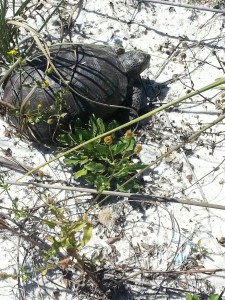
This gopher tortoise was found in the dune fields on a barrier island – an area where they were once found.
Photo: DJ Zemenick
The gopher tortoise is one of only two true land dwelling turtles in our area and is in a family all to its own. They are miners, digging large burrows that can extend up to a depth of 7 feet and a length of 15 feet underground. However, tortoises are not very good at digging up towards the surface, so there is only the one entrance in and out of the burrow. The burrow of the tortoise can be distinguished from other burrowing animals, such as armadillos, in that the bottom line of the opening is flat – a straight line – and the top is domed or arched shaped; mammalian burrows are typically round – circular. Tortoise burrows also possess a layer of dirt tossed in a delta-shaped fan out away from the entrance (called an apron). Many times the soil is from deeper in the ground and has a different color than the soil at the surface. The general rule is one burrow equals one tortoise, though this is not always true. Some burrows are, at times, shared by more than one and some may not be occupied at all. Many field biologists will multiple the number of burrows by 0.6 to get an estimate of how many tortoises there are in the area.
The tortoise itself is rather large, shell lengths reaching 15 inches. They can be distinguished from the other land dwelling turtle, the box turtle, by having a more flattened dome to the shell and large elephant like legs. The forelimbs are more muscular than the hind and possess large claws for digging the burrow. They are much larger than box turtles and do not have hinged plastrons (the shell covering the chest area) and cannot close themselves up within the shell as box turtles can. Tortoises prefer dry sandy soils in areas where it is more open and there are plenty of young plants to eat; box turtles are fans of more dense brush and wooded areas.
Tortoises spend most of the day within their burrows – which remain in the 70°F range. Usually when it is cooler, early morning or late afternoon, or during a rain event – the tortoises will emerge and feed on young plants. You can see the paths they take from their burrows on foraging trips. They feed on different types of plants during different type times of the year to obtain the specific nutrients. There are few predators who can get through the tough shell, but they do have some and so do not remain out for very long. Most people find their burrows, and not the tortoise. You can tell if the burrow has an active tortoise within by the tracks and scrap marks at the entrance. Active burrows are “clean” and not overgrown with weeds and debris. Many times, you can see the face of the tortoise at the entrance, but once they detect you – they will retreat further down. Many times a photo shot within a burrow will reveal the face of a tortoise in the picture. There is a warning here though. Over 370 species of creatures use this burrow to get out of the weather along with the tortoise – one of them is the diamondback rattlesnake. So do not stick your hand or your face into the entrance seeking a tortoise.
Most of the creatures sharing the burrow are insects but there are others such as the gopher frog and the gopher mouse. One interesting member of the burrow family is the Eastern Indigo Snake. This is the largest native snake to North America, reaching a length of eight feet, and is a beautiful iridescent black color. It is often confused with the Southern Black Racer. However, the black racer is not as long, not as large around (girth), and possess a white lower jaw instead of the red-orange colored one of the indigo. The indigo is not dangerous at all, actually it feeds on venomous snakes and it is a good one to have around.
Federal and state laws protect the indigo, as with the gopher frog and mouse. All of these animals have declined in number over the past few decades. This is primarily due to loss of the needed gopher burrows, which have declined because the tortoises have declined, and this is due to habitat loss and harvesting. Again, tortoises like dry sandy soils for digging burrows. They prefer wooded areas that are more open and allow the sun to reach the forest floor where young grasses and flowers can grow. The longleaf pine forest is historically the place to find them but they are found in coastal areas where such open wooded areas exist. The lack of prescribe burning has been a problem for them. Florida is the number one state for lightning strikes. Historically, lightning strikes would occasionally start fires, which would burn the underbrush and allow grasses to grow. In recent years, humans have suppressed such fires, for obvious reasons, and the tortoise community has suffered because of it. Therefore, we now have prescribe fire programs on most public lands in the area. This has helped to increase the number of tortoises in the area and your chance of seeing one.
All of the members of the tortoise community are still protected by state, and – in the case of the indigo snake – federal law, so you must not disturb them if seen. Photos are great and you should feel lucky to have viewed one. Though they could be found anywhere where it is high, dry, and somewhat open – the state and national parks are good places to look.
Reference
Meylan, P.A. (Ed.). 2006. Biology and Conservation of Florida Turtles. Chelonian Research Monographs No. 3, 376 pp.
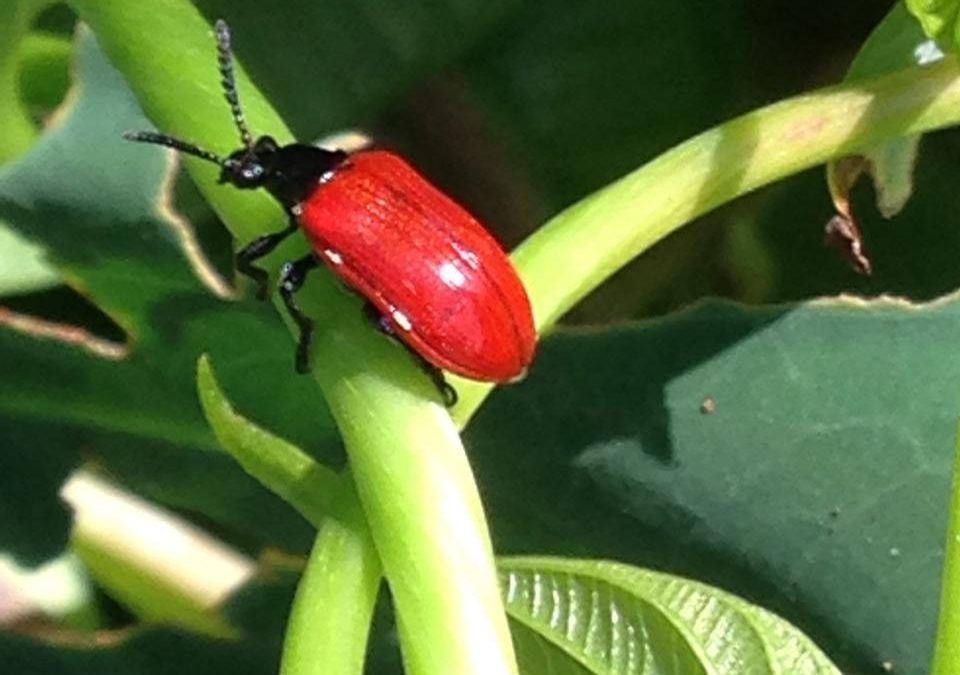
by Scott Jackson | May 25, 2018
By L. Scott Jackson and Julie B. McConnell, UF/IFAS Extension Bay County
Northwest Florida’s pristine natural world is being threaten by a group of non-native plants and animals known collectively as invasive species. Exotic invasive species originate from other continents and have adverse impacts on our native habitats and species. Many of these problem non-natives have nothing to keep them in check since there’s nothing that eats or preys on them in their “new world”. One of the most problematic and widespread invasive plants we have in our local area is air potato vine.
Air potato vine originated in Asia and Africa. It was brought to Florida in the early 1900s. People moved this plant with them using it for food and traditional medicine. However, raw forms of air potato are toxic and consumption is not recommended. This quick growing vine reproduces from tubers or “potatoes”. The potato drops from the vine and grows into the soil to start new vines. Air potato is especially a problem in disturbed areas like utility easements, which can provide easy entry into forests. Significant tree damage can occur in areas with heavy air potato infestation because vines can entirely cover large trees. Some sources report vine growth rates up to eight inches per day!
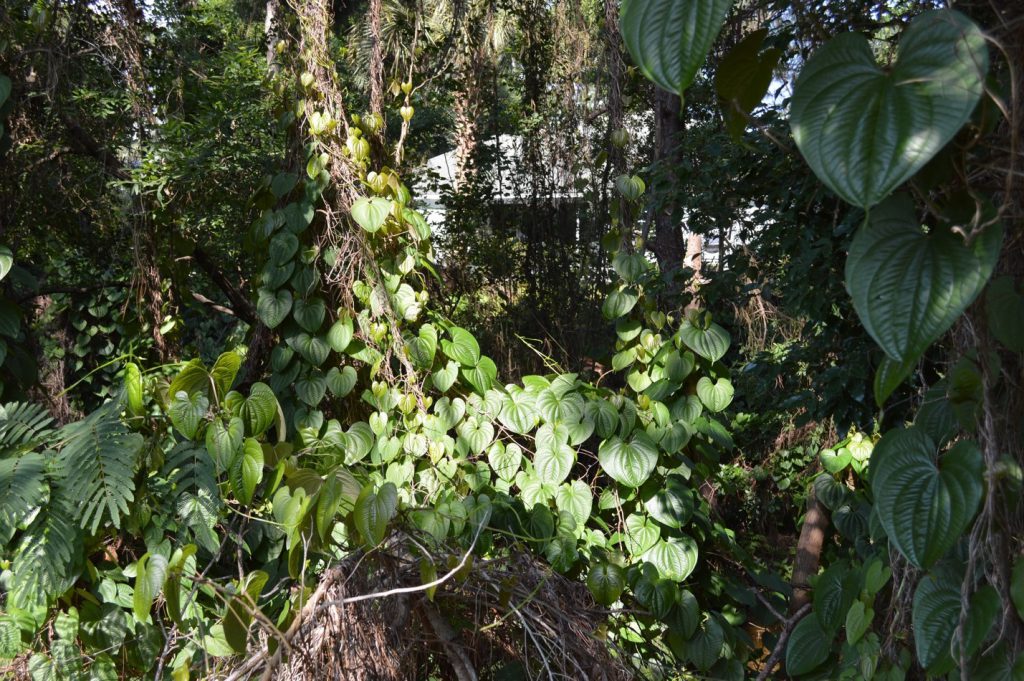
Air Potato vines covering native shrubs and trees in Bay County, Florida. (Photo by L. Scott Jackson)
Mechanical removal of vines and potatoes from the soil is one control method. Additionally, herbicides are often used to remediate areas dominated by air potato vine but this runs the risk of affecting non-target plants underneath the vine. A new tool for control was introduced to Florida in 2011, the air potato leaf beetle. Air potato beetle releases have been monitored and evaluated by United States Department of Agriculture (USDA) researchers and scientists for several years.

Air Potato Beetle crawling on leaf stem. Beetles eat leaves curtailing the growth and impact of air potato. (Photo by Julie B. McConnell)
Air potato beetles target only air potato leaves making them a perfect candidate for biological control. Biological controls aid in the management of target invasive species. Complete eradication is not expected, however suppression and reduced spread of air potato vine is realistic.
UF/IFAS Extension Bay County will host the Air Potato Challenge on June 6, 2018. Citizen scientist will receive air potato beetles and training regarding introduction of beetles into their private property infested with air potato vine. Pre-registration is recommended to receive the air potato beetles. Please visit http://bit.ly/bayairpotato
In conjunction with the Air Potato Challenge, UF/IFAS Extension Bay County will be hosting an invasive species awareness workshop. Dr. Steve Johnson, UF/IFAS Associate Professor of Wildlife Ecology, will be presenting “Exotic Invaders: Reptiles and Amphibians of Concern in Northwest Florida”. Additionally, experts from UF/IFAS Extension, Florida Fish and Wildlife, and the Science and Discovery center will have live exhibits featuring invasive reptiles, lionfish, and plants. For more information visit http://bay.ifas.ufl.edu or call the UF/IFAS Extension Bay County Office at 850-784-6105.
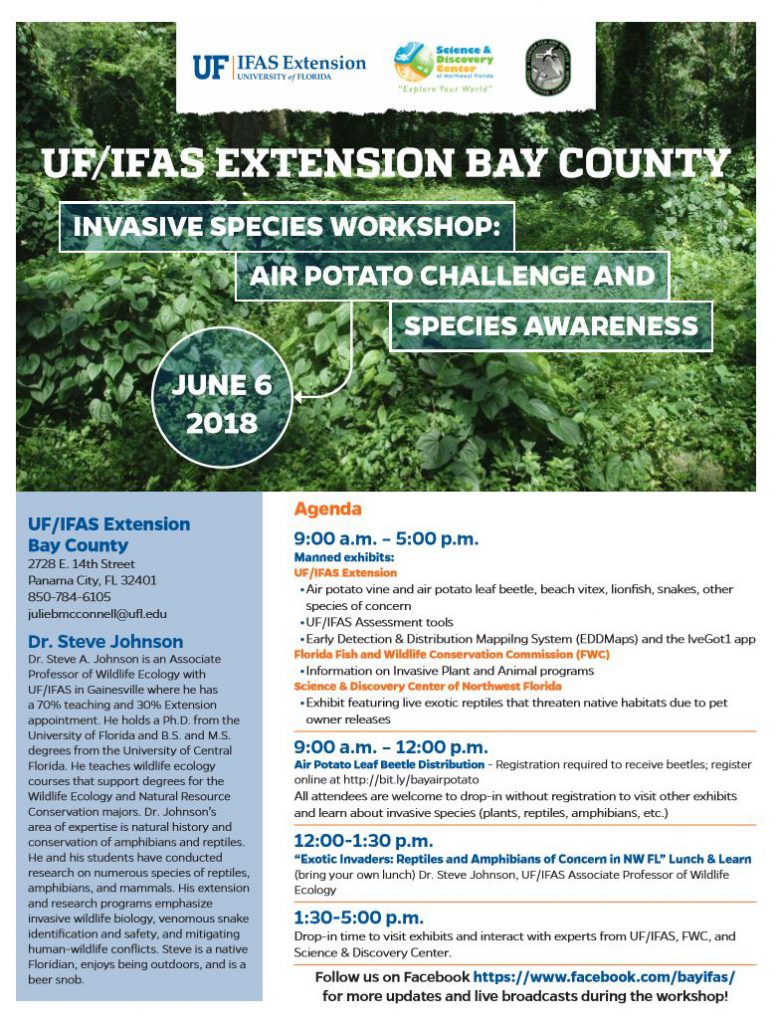
Flyer for Air Potato Challenge and Invasive Species Workshop June 6 2018

by hollyober | Mar 18, 2018
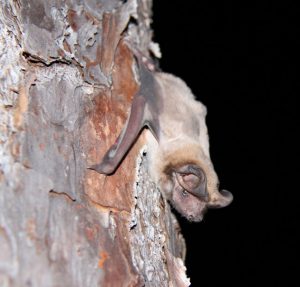
Bats sometimes move into buildings when they can’t find the natural structures they prefer (caves and large trees with cavities).
All 13 species of bats that live in Florida sleep during the day and feed on insects throughout the night. Most of these bats sleep in natural structures such as trees and caves. But when the natural structures these bats prefer are limited or vandalized, the bats may move into buildings.
Bats are a great help to us. Each of them consumes hundreds of insects per night. Bats save growers billions of dollars annually by reducing insect pests. Some of the pests bats feed on include the damaging fall armyworm, cabbage looper, corn earworm, tobacco budworm, hickory shuckworm, and pecan nut casebearer. But both bats and humans are happier when not sharing living spaces!
If you or someone you know has a group of bats living in a building where they are not welcome, you have options. The safe, humane, effective way to coax a colony of bats out of a building permanently is through a process called an ‘exclusion’. A bat exclusion is a process that prevents bats from returning to a building once they have exited at sunset to feed. This is accomplished by installing a temporary one-way door. This one-way door can take many forms, but the most common is a sheet of plastic mesh screening (with small mesh size of 0.125 x 0.125 inches or less) attached at the top and along both sides of the sheet, and open on the bottom. Another option is to install slick tubes (such as clean caulk tubes) to such entry points. These temporary one-way doors should be attached over each one of the suspected entry/exit points bats are using to get in and out of the building.
It is illegal to harm or kill bats in Florida. However, excluding bats from a building is allowed if you follow practices recommended by the Florida Fish and Wildlife Conservation Commission (FWC). According to Florida law, all bat exclusion devices must be left in place for a MINIMUM of 4 consecutive nights with temperatures above 50⁰ F before each entry point can be permanently sealed to prevent bat re-entry. Also, it is unlawful in Florida to attempt to exclude bats from a building between April 15 and August 15, which is bat maternity season. This is when female bats form large colonies and raise young that are unable to fly for their first few weeks of life. If bats were excluded during this time period, young bats (pups) would die indoors.
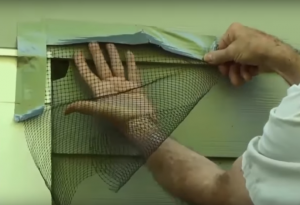
Bats can be coaxed to leave a building by first identifying the bat’s entry points into the building, and then creating a temporary one-way door using plastic screening with fine mesh size over each of these entry points.
The steps for an effective exclusion are as follows:
- Identify the locations where bats are getting in and out of the building. Look for holes or crevices about the width of your thumb, often near the roofline, with brown staining on the exterior of the building and bat scat (guano, about the size of a grain of rice and brown in color) below.
- Fashion and install one-way doors at each suspected bat entry point. This can be done anytime between August 16 and April 14 – it cannot be done when bats have young pups, which is between April 15 and August 15.
- Leave all one-way doors in place for at least 4 consecutive nights with minimum temperatures above 50⁰ F so all bats leave through the doors and cannot re-enter. If any one-way door becomes ineffective during the 4 day period, begin again. You must be absolutely certain all bats have exited so you do not block any inside the building.
- Immediately after removing the one-way doors, permanently seal each hole to prevent bats from getting back inside.
For detailed instructions on how to conduct a bat exclusion, see this video that features interviews with bat biologists from the University of Florida, FWC, and the Florida Bat Conservancy: How to Get Bats out of a Building.
For additional information on Florida’s bats, visit University of Florida’s bat advice or FWC’s bat website.
Remember, if you have a colony of bats roosting indoors that you want to exclude, you must either act within the next few weeks or else wait until the middle of August to coax them out. Bat maternity season in Florida runs from April 15 to August 15, and during this time no one can attempt to exclude bats from a building.

by Sheila Dunning | Jan 19, 2018
 The Florida Master Naturalist Program is an adult education University of Florida/IFAS Extension program. Training will benefit persons interested in learning more about Florida’s environment or wishing to increase their knowledge for use in education programs as volunteers, employees, ecotourism guides, and others.
The Florida Master Naturalist Program is an adult education University of Florida/IFAS Extension program. Training will benefit persons interested in learning more about Florida’s environment or wishing to increase their knowledge for use in education programs as volunteers, employees, ecotourism guides, and others.
Through classroom, field trip, and practical experience, each module provides instruction on the general ecology, habitats, vegetation types, wildlife, and conservation issues of Coastal, Freshwater and Upland systems. Additional special topics focus on Conservation Science, Environmental Interpretation, Habitat Evaluation, Wildlife Monitoring and Coastal Restoration. For more information go to: http://www.masternaturalist.ifas.ufl.edu/ Okaloosa and Walton Counties will be offering Upland Systems on Thursdays from February 15- March 22. Topics discussed include Hardwood Forests, Pinelands, Scrub, Dry Prairie, Rangelands and Urban Green Spaces. The program also addresses society’s role in uplands, develops naturalist interpretation skills, and discusses environmental ethics. Check the website for a Course Offering near you :http://conference.ifas.ufl.edu/fmnp/
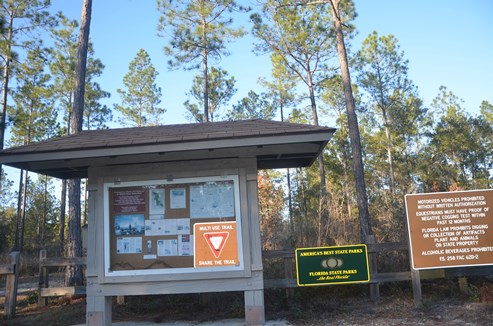
by Les Harrison | Jan 5, 2018

St. Marks River Preserve State Park is still being developed, but open for native habitat enthusiast and those who enjoy this environment as nature established it.
Located along the banks of the St. Marks River’s headwaters, this park offers an extensive system of trails for hiking, horseback riding, and off-road bicycling. The existing road network in the park takes visitors through upland pine forests, hardwood thickets and natural plant communities along the northern banks of the river.
The St. Marks River is not navigable within the park boundaries. It is not conducive to canoeing or kayaking unless visitors are willing to accept long portages through thick undergrowth.
Most of the trails are dry and sandy, but plan for the low water crossings which some of the trails traverse. The rainy months of summer increase the prospects of water crossings.
This preserve is home to a wide variety of native fauna including black bear, deer, turkey and much more. Wildlife tracks frequently crisscross the park’s roads and trails.
At the northern end of the park two sections have had timber removed. One plot has been replanted with wiregrass seed which should germinate this year. Both areas have been planted with long-leafed pine seedlings.
This preserve offers avian aficionados the opportunity to witness nature at its finest as birds fill the air with their calls. A wide assortment of residential and migratory birds can be viewed in their natural habitat.
There are currently no amenities available at the park and it does not have restroom facilities. Additionally, visitors must bring in water for themselves or their horse.
There are no fees presently required to enjoy this gem of a park. Located east of Tallahassee, it is 3.5 miles east of W.W. Kelly Road on Tram Rd (Leon County Highway 259) almost to the Jefferson County line.
Adequate planning should be made to pack in and pack out all needed items for the day. The nearest convenience stores are located in Wacissa a few miles west of the park on Tram Road.
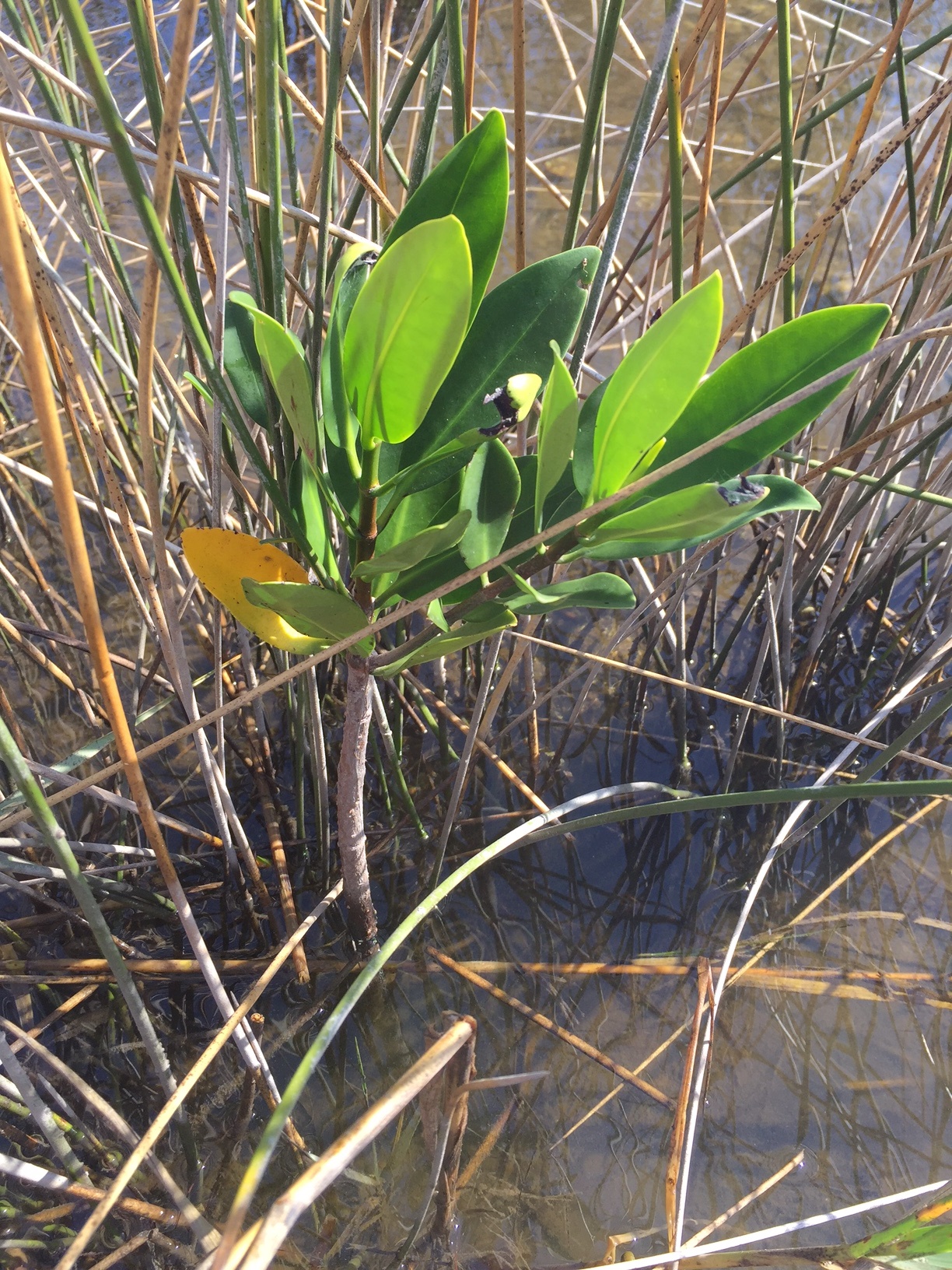
by Carrie Stevenson | Nov 3, 2017
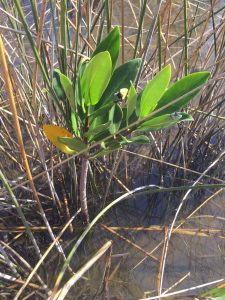
Red mangrove growing among black needlerush in Perdido Key. Photo credit: Carrie Stevenson, UF IFAS Extension
Discovering something new is possibly the most exciting thing a field biologist can do. As students, budding biologists imagine coming across something no one else has ever noticed before, maybe even getting the opportunity to name a new bird, fish, or plant after themselves.
Well, here in Pensacola, we are discovering something that, while already named and common in other places, is extraordinarily rare for us. What we have found are red mangroves. Mangroves are small to medium-sized trees that grow in brackish coastal marshes. There are three common kinds of mangroves, black (Avicennia germinans), white (Laguncularia racemosa), and red (Rhizophora mangle).
Black mangroves are typically the northernmost dwelling species, as they can tolerate occasional freezes. They have maintained a large population in south Louisiana’s Chandeleur Islands for many years. White and red mangroves, however, typically thrive in climates that are warmer year-round—think of a latitude near Cedar Key and south. The unique prop roots of a red mangrove (often called a “walking tree”) jut out of the water, forming a thick mat of difficult-to-walk-through habitat for coastal fish, birds, and mammals. In tropical and semi-tropical locations, they form a highly productive ecosystem for estuarine fish and invertebrates, including sea urchins, oysters, mangrove and mud crabs, snapper, snook, and shrimp.
Interestingly, botanists and ecologists have been observing an expansion in range for all mangroves in the past few years. A study published 3 years ago (Cavanaugh, 2014) documented mangroves moving north along a stretch of coastline near St. Augustine. There, the mangrove population doubled between 1984-2011. The working theory behind this expansion (observed worldwide) is not necessarily warming average temperatures, but fewer hard freezes in the winter. The handful of red mangroves we have identified in the Perdido Key area have been living among the needlerush and cordgrass-dominated salt marsh quite happily for at least a full year.

Key deer thrive in mangrove forests in south Florida. Photo credit: Carrie Stevenson, UF IFAS Extension
Two researchers from Dauphin Island Sea Lab are planning to expand a study published in 2014 to determine the extent of mangrove expansion in the northern Gulf Coast. After observing black mangroves growing on barrier islands in Mississippi and Alabama, we are working with them to start a citizen science initiative that may help locate more mangroves in the Florida panhandle.
So what does all of this mean? Are mangroves taking over our salt marshes? Where did they come from? Are they going to outcompete our salt marshes by shading them out, as they have elsewhere? Will this change the food web within the marshes? Will we start getting roseate spoonbills and frigate birds nesting in north Florida? Is this a fluke due to a single warm winter, and they will die off when we get a freeze below 25° F in January? These are the questions we, and our fellow ecologists, will be asking and researching. What we do know is that red mangrove propagules (seed pods) have been floating up to north Florida for many years, but never had the right conditions to take root and thrive. Mangroves are native, beneficial plants that stabilize and protect coastlines from storms and erosion and provide valuable food and habitat for wildlife. Only time will tell if they will become commonplace in our area.
If you are curious about mangroves or interested in volunteering as an observer for the upcoming study, please contact me at ctsteven@ufl.edu. We enjoy hearing from our readers.














